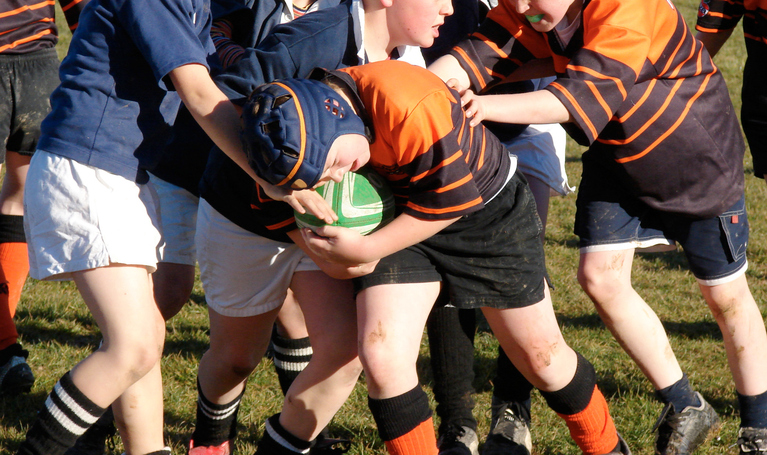By Drs. Adam White @AdamJohnWhite and Melanie Lang @DrMelLang
THE BACKGROUND TO TACKLING IN SCHOOLS’ RUGBY
Schools’ rugby is currently receiving significant scrutiny as a result of the injuries, particularly concussions, that are frequently an outcome of tackling. [1] We, and the Sport Collision Injury Collective, called upon the UK and devolved governments to remove the tackle from schools’ physical education. This call was necessary because, (a) rugby has a high incidence of severe injuries, [2] (b) many children are compelled to participate in contact rugby as part of school Physical Education, [2] (c) the tackle is the core mechanism for injury in rugby, [2] and (d) concussions are common and the long-term impacts are concerning. [2] So far, the debate has neglected a safeguarding approach that focuses upon the prevention of harm to children. [3]

THE PRINCIPLES OF SAFEGUARDING IN SPORT
The term ‘safeguarding’, introduced by the New Labour government in its Green Paper Every Child Matters and related legislation The Children Act 2004, epitomizes the UK’s future-orientated, social-investment approach to children and their welfare. Safeguarding is defined as:
… protecting children from maltreatment; preventing impairment of children’s health or development; ensuring that children are growing up in circumstances consistent with the provision of safe and effective care; and taking action to enable all children to have the best outcomes. [4]
Safeguarding, then, involves acting proactively to prevent risk and impairment of children’s health and development so as to minimise harm and enhance children’s overall development, health and wellbeing. This child-centred approach requires that child-related settings embed and enact policies and practices based on the best interests of the child and “maximis[e] protective factors and processes”. [5] Importantly schools, which are identified as a key part of the child welfare system because staff are well placed to identify potential issues early and support children’s positive development, have a statutory duty to safeguard children in their care as set out in The Education Act 2002.
PREVENTING HARM
The extent of injuries in youth sport is under-studied. A recent study of schoolboy’s rugby in Northern Ireland found that over the course of a season, 37% of participants were injured at least once. Of the 424 recorded injuries, 49% of them required 28 or more days away from play and 19% of injuries (n=81) were diagnosed as concussion. [6] The long-term consequences of concussion are not fully known, yet the evidence available suggests an array of neurodegenerative conditions. [7] The removal of the tackle would be the most effective mechanism for preventing harm to children. [8]
UNNECESSARY HARM
In the school Physical Education setting, there is no need or mandatory requirement to deliver tackling or contact sport, meaning the inclusion of contact rugby is at the discretion of individual schools. Likewise, there is currently no evidence of the benefits that are unique to tackling and unobtainable from other, less risky, physical activities. Tackling is unnecessary to meet the educational needs of children, and therefore the risks are also unnecessary. [9]
PRECAUTIONARY APPROACH
The precautionary approach aligns to safeguarding principles, putting the child’s wellbeing at the centre of decision-making. The Inter-Departmental Liaison Group on Risk Assessment suggests that the precautionary principle can be invoked:
… where there is little scientific uncertainty, Government Departments may be cautionary in situations where… the nature of a hazard, or those exposed to a hazard, reduce the extent of society’s toleration of risk, e.g. where… those exposed to a hazard are considered to be vulnerable or disadvantaged (e.g. children). [10]
Therefore, recognising that tackling is the primary mechanism for injuries, and it is not a necessary component of the school Physical Education curriculum, in accordance with a safeguarding approach, tackling should be removed from the school context until preventative measures can reduce the risk of injury for children. [11]
REFERENCES
- Sport Collision Injury Collective, Open Letter: preventing injuries in children playing school rugby 2016; www.sportcic.com/resources/Open%20Letter%20SportCIC%20March1st%202016.pdf (accessed 22 Mar 2017).
- Pollock A M, White A J, Kirkwood G, Evidence in support of the call to ban the tackle and harmful contact in school rugby: a response to World Rugby. Br J Sports Med 2017; 51 (15): 1113-1117.
- Lang, M, Hartill, M, (Eds.) Safeguarding, child protection and abuse in sport: international perspectives in research, policy and practice. London: Routledge 2015.
- Department for Education, Working together to safeguard children: a guide to inter-agency working to safeguard and promote the welfare of children. London: HMSO 2015; 85.
- Parton N, Child protection and safeguarding in England: changing and competing conceptions of risk and their implications for social work. Br J Soc Work 2011; 41 (5): 854-875.
- Archbold H A P, Rankin A T, Webb M, et al. RISUS study: rugby injury surveillance in Ulster schools. Br J Sports Med; 51 (7): 600-606.
- Wilson L, Stewart W, Dams-O’Connor K, et al. The chronic and evolving neurological consequences of traumatic brain injury. The Lancet Neurology 2017; 16 (10): 813-825.
- Cross M J, Tucker R, Raftery M, et al. Tackling concussion in professional rugby union: a case-control study of tackle-based risk factors and recommendations for primary prevention. Br J Sports Med. Published Online First: 11 October2017. doi: 10.1136/bjsports-2017-097912
- Molcho M, Pickett W, Some thoughts about ‘acceptable’ and ‘non-acceptable’ childhood injuries. Inj Prev 2011; 17: 147-148.
- Inter-Departmental Liaison Group on Risk Assessment, The precautionary principle: policy and application; http://www.hse.gov.uk/aboutus/meetings/committees/ilgra/pppa.pdf (accessed 21st October 2017).
- Batten J, White A J, Anderson E, Bullingham R, From management to prevention: the new cure for sports concussion. Br J Sports Med 2016; 50 (21): 1293-1294.